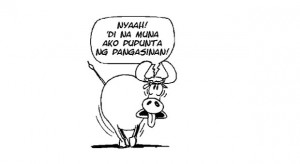Carabao vanishing in Pangasinan
 LINGAYEN, Pangasinan—The carabao, the country’s national animal, is fast vanishing in Pangasinan province, according to an official of the Philippine Carabao Center (PCC) in the Ilocos region.
LINGAYEN, Pangasinan—The carabao, the country’s national animal, is fast vanishing in Pangasinan province, according to an official of the Philippine Carabao Center (PCC) in the Ilocos region.
“At the rate carabaos are being slaughtered for meat and meat products, the animal will completely vanish in 10 years,” said Gloria de la Cruz, director of the PCC based at Don Mariano Marcos Memorial State University in La Union province.
Records of the Bureau of Agricultural Statistics showed that the number of carabaos slaughtered in Pangasinan increased from 9,502 in 2010 to 11,252 in 2012.
“You know, carabao meat is cheaper than beef. But, ironically, the nutritional value of carabao meat is higher than that of beef and goat meat,” De la Cruz said at a news conference on Wednesday.
As a result, the province’s carabao population decreased from 110,268 in 2010 to 77,609 in 2012.
Pangasinan’s carabao population in 2010 accounted for 60 percent of the carabao population in the Ilocos region. In 2012, it was down to about 50 percent.
“I told a group of meat processors in Mangaldan [town], ‘If we continue to slaughter, OK, we have business today. How about in 10 years? Will we still have business? I think we will no longer have tapa (dried meat) and even pigar-pigar (deep-fried carabao meat) because, by then, we no longer have carabaos,’” De la Cruz said.
Only 14 towns and Alaminos City have a “good” number of carabaos in the province, said Dr. Eric Jose Perez, provincial veterinarian.
He said that last year, meat and meat products produced from carabao were about 6,685 metric tons, below the Pangasinan consumers’ demand of 8,867 MT.
Crossbreed also slaughtered
De la Cruz said the PCC started crossbreeding carabaos in the province with foreign-bred Murrah buffaloes through artificial and natural insemination in 1999.
“But based on our findings, the offspring, which were improved breeds, were slaughtered, [negating] our efforts,” she said.
Protecting females
To arrest the dwindling carabao population in Pangasinan, De la Cruz said she met with Perez last year and together, they lobbied the provincial board for the enactment of an ordinance that would regulate the sale or slaughter of female carabaos in the province. The ordinance was passed.
“This is the first ordinance of its kind in the country that will hopefully help stop the downswing of the carabao population in Pangasinan,” De la Cruz said.
Under the ordinance, anyone caught selling and slaughtering a “quality” carabao will be punished. First offenders will be reprimanded and will be required to attend a one-hour orientation on the ordinance. Second offenders will lose their license to transport livestock.
Buy-back plan
The ordinance also established a buy-back plan in which the provincial government buys breedable female carabaos to be distributed as additional stocks to dairy cooperatives in the province.
De la Cruz thanked Pangasinan Gov. Amado Espino Jr. for approving the initial allocation of P1.5 million, and P500,000 in the succeeding years, for the buy-back scheme.
She said the PCC had also intensified its upgrading activities in the province to produce better quality carabaos.
“I will not give up, despite the decreasing population of our carabaos. We are doing our best to have more carabaos in the province,” De la Cruz said.
Nationwide trend
At the news conference, De la Cruz announced that the PCC was giving two cooperatives 30 Bulgarian Murrah buffaloes each for their dairy project.
She said her office and local governments would conduct an information caravan to educate farmers about carabao raising.
De la Cruz said that although the decreasing carabao population was more visible in Pangasinan, it was also a nationwide trend.
“This is why in other provinces, we also conduct crossbreeding activities and encourage farmers not to slaughter their carabaos,” she said.
According to the PCC website, the carabao population in the country in the last decade was characterized by a “period of decline” from 1991 to 1994 and a period of “erratic growth” from 1995 to 2010.
“The dramatic decline in population in 1991–1994 coincided with a clear rise in the slaughter rate, pointing to an obvious direct cause and effect relationship between these two variables,” the PCC website said.
Carabao Act
De la Cruz said that aside from the Philippine Carabao Act of 1992 (Republic Act No. 7307), which was authored by then Sen. Joseph Estrada, there should be a law banning the slaughter of carabaos.
“I really hope a law concerning the preservation of our carabaos will be passed. In the entire country, the carabao population continues to go down,” De la Cruz said.
She said the late Sorsogon Rep. Salvador Escudero III had filed a bill that would ban the slaughtering of carabaos. This was approved by the House of Representatives but the measure remained pending in the Senate.
“I hope they will revive the bill, or better still adopt the Pangasinan ordinance,” De la Cruz said.
“I do not want us to be in a situation where we no longer have any carabao left. When that time comes, the next generation will just be seeing carabaos as figurines or statues in museums,” she said.
RELATED STORIES
More than a fashion parade by carabaos
With summer ending, image of carabao as fiesta star lingers














